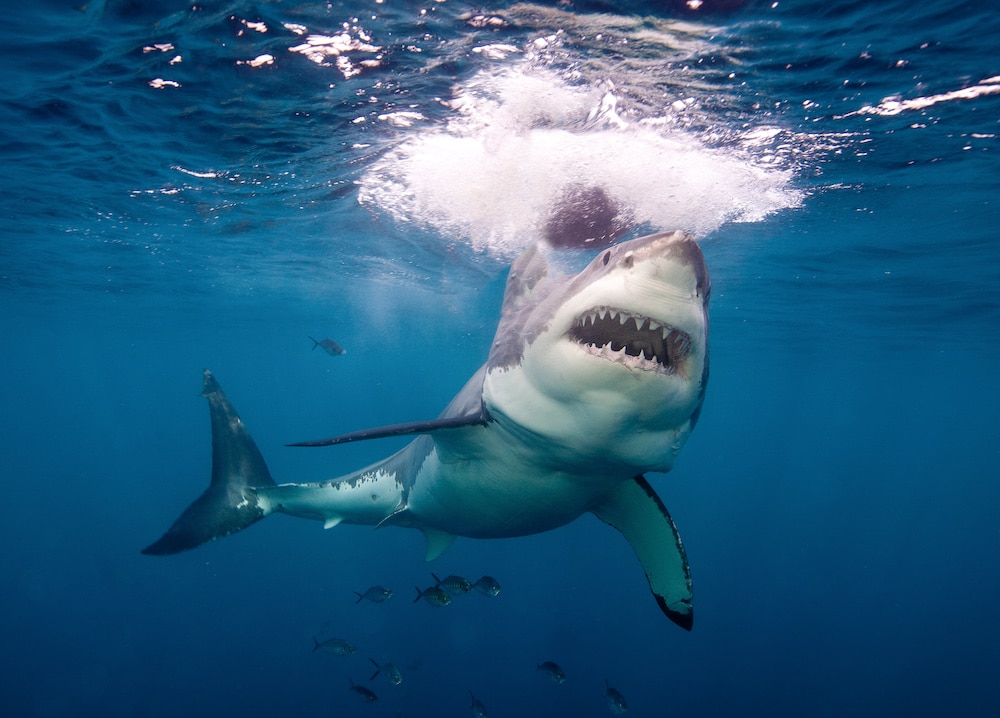Create a free profile to get unlimited access to exclusive videos, sweepstakes, and more!
Do Great White sharks actually have (shudder) friends?
Whatever they're talking about, you may not want to get close enough to listen.

You would think they’d bite each other’s heads off, especially with the reputation Jaws gave them, but Great White sharks can actually socialize without it ending in blood.
The only thing about shark cliques that will involve blood is if the others take a cue from one of their friends’ hunting tactics. This could be one of the reasons they get social in the first place, if you ask researcher Yiannis Papastamatiou of Florida International University, who led a study recently published in Biology Letters. He and his team tagged white sharks from a population that swarms around Mexico’s Guadalupe Island every summer to see who was friends with who.
“We can only speculate at this point, but hunting is the most likely explanation as information on the location of prey or a kill that would be useful, even though the sharing of information is probably unintentional and inadvertent,” he told SYFY WIRE.
Sharks are not the only social creatures, but while other animals may communicate warnings about approaching predators, the Great White doesn’t really have that issue. What makes Guadalupe Island different from other shark hangouts (besides the all-you-can-eat buffet of tuna and seals) is its clear waters. Murky waters force sharks to ambush prey, but Papastamatiou and his team wanted to see if they changed their hunting strategies when that prey was visible. This is why they created a tag that would track a shark’s activity for up to five days of swimming.
You can’t use just any tracking device on a Great White shark. Never mind the legendary Jaws, these beasts are around 6 to 9 feet long, which meant that the researchers were going to have to create a gadget that would stay on the shark’s dorsal fin for a long enough stretch. What they came up with used a mashup of technologies to track social activity. It involved a video camera with sensors that could track how deep the shark swam and in what direction it was going, and also how fast it accelerated and turned. This tag stayed on for up to five days before floating to the surface.
There was one shark that revealed it had been “talking” to 12 sharks over only 30 hours. Another only interacted with two the entire time its tag was attached, but why?
“Some sharks only had associations during the day, and some detected other sharks at night as well,” said Papastamatiou. “We might expect social associations to be more useful during the day as sharks can see better, but we don’t have enough data to confirm that.”
There was also something in the way when the sun was out. Because a cage diving operation was going on, sharks were being attracted to the cages, which could have influenced when they were most active. Most were around in the early afternoon. Why that one shark seemed kind of antisocial is also a mystery. It was one of the largest tagged, but there was just not enough evidence to prove that its imposing size might have scared off some of the others. Whether it wanted to keep its hunting tactics to itself or was just more of a loner is also unknown.
Mauricio Hoyos-Padilla, who coauthored the study and is Chief Scientist at Fins Attached Marine Research and Conservation, has been tagging white sharks at Guadalupe Island for years and was behind the upgraded tag used on those which were part of this study. He wonders whether shark interactions might have something to do with seeking out a potential mate.
"We are really very interested in the interactions of males-females because some scientists believe that these aggregation sites could be suitable for mating," he also told SYFY WIRE.
Sharks were found to stay in waters shallower than 300 feet, though individuals could be found almost everywhere within that depth. About half of them tended to swim slower the further down they ventured, while the other half picked up speed for some reason. Fast twists and turns were observed mostly near the surface for one half and deeper down for the other. There were, however no ambushes. Some sharks had difficulty catching their dinner because of the high visibility. Maybe this is the reason that they interacted with their more successful peers.
Most of the Great Whites leave the Guadalupe Island feeding frenzy in the spring, but Papastamatiou has more questions as to what they do after taking off.
“Are they traveling together when they leave? Our ultimate question is to measure their social associations over much longer time periods,” he said. “To answer those questions, we have to figure out how to measure sociality over much longer periods of time.”
No word on whether animatronic Jaws star Bruce told any of them to say hi.


























